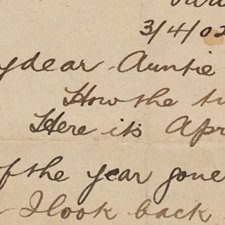Hugh Ramsay studied at the National Gallery School in Melbourne before sailing to Europe on the same ship as fellow artist George Lambert in 1899. For 15 months he painted and partied in a cold, grimy Paris studio, gaining some critical success while depending on the Lamberts for an occasional hot meal. In 1902 four of his paintings were chosen for exhibition at the New Salon, Paris; this extraordinary achievement earned him the patronage of Dame Nellie Melba, a relative of his friend, artist Ambrose Patterson (1877–1967). Ramsay painted several portraits of Patterson, whose studio was in the same apartment block in Montparnasse. Here Patterson is captured in profile, with his left arm extended in a strong horizontal line that drops elegantly at the wrist over the back of a leather armchair. The portrait, gifted to Patterson in friendship, was damaged while stored in Belgium and subsequently cut down leaving only the top half of the figure. When Ramsay fell ill with tuberculosis, Melba funded his return to Victoria. He worked hard, amassing works for a solo exhibition (held at Melba’s rented home in Toorak) before dying at the age of 28.
Gift of the Estate of John Oswald Wicking 2003
The portrait of artist Ambrose Patterson painted by fellow artist and friend Hugh Ramsay in 1901-02 is an oil on canvas and measures 90.5 centimetres by 111.8 centimetres.
The portrait is a tonal poem of cream, mustard yellow and warm browns.
On the left-hand side of the background is a large piece of heavy wooden furniture with a deeply carved panelled front, while on the right there is a mustard yellow wall above dark wooden panelling.
Ambrose sits side on, his face in profile, with his left arm draped across the top edge of the chair back.
His short dark brown hair flops generously over his high forehead, is trimmed neatly around his pale pink ear and shaped to the nape of his neck. His dark deep-set eye has a dark shadow beneath it, strongly contrasting with his pale creamy skin. His nose is large and slightly hooked and there is the hint of a moustache on his upper lip, his pale pink lips partially open as if caught in conversation. His pointed chin and strong jaw line are intensely defined above his wide long neck.
Ambrose wears a cream round-necked knitted jumper with a check shirt revealed at collar and cuffs.
His left hand draped across the back of the chair is clasping four long fine paint brushes. The twist of his torso is emphasized by folds in the jumper sweeping down from his left shoulder to the right-hand side of his waist. His body and right arm face forward with the sleeve of his jumper pushed up above his elbow.
Audio description written and voiced by Krysia Kitch
John O. Wicking (2 portraits)



On one level The Companion talks about the most famous and frontline Australians, but on another it tells us about ourselves.



Inga Walton on the brief but brilliant life of Hugh Ramsay.



Hugh Ramsay's letters were written while he was living in Paris to his family back in Australia.